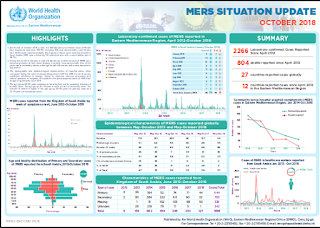#13,667
WHO's EMRO (Eastern Mediterranean Regional Office) has released their latest monthly summary of global MERS cases, showing 8 cases in October, all from Saudi Arabia. One of the cases is described as a secondary household contact.
While the chart above shows a dramatic drop in large - mostly healthcare related - outbreaks since 2016, the rate of community acquired cases remains little changed.Camel exposure accounts for only a portion of these community cases, raising questions about how, and how well, the virus might be spreading via asymptomatic or mildly infected individuals.
Over the past month, a few on-point studies include:
mBio: High Prevalence of MERS-CoV Infection in Camel Workers in Saudi Arabia
AJIC:Intermittent Positive Testing For MERS-CoV
JIDC: Atypical Presentation Of MERS-CoV In A Lebanese PatientAnd in August - in Evaluation of a Visual Triage for the Screening of MERS-CoV Patients - we looked at what has been described as a serious flaw in Saudi Arabia's MERS surveillance program.
The latest EMRO MERS summary reads:
MERS situation update, October 2018
And finally, yesterday KSA announced their fourth MERS case for epi week 45 (see below), which is the second secondary household infection reported this week. The first was in Riyadh, while this one is from Qaseem.
- At the end of October 2018, a total of 2266 laboratory-confirmed cases of Middle East respiratory syndrome (MERS), including 804 associated deaths (case–fatality rate: 35.5%) were reported globally; the majority of these cases were reported from Saudi Arabia (1888 cases, including 730 related deaths with a case–fatality rate of 38.7%).
- During the month of October, a total of 8 laboratory-confirmed cases of MERS were reported globally (all from Saudi Arabia), including 1 associated death. One of the cases was a secondary infection through household contact with a case reported in September.
- The demographic and epidemiological characteristics of reported cases, when compared during the same corresponding period of 2013 to 2018, do not show any significant di erence or change. Owing to improved infection prevention and control practices in hospitals, the number of hospital-acquired cases of MERS has dropped significantly since 2015.
- The age group 50–59 years continues to be at highest risk for acquiring infection of primary cases. The age group 30–39 years is most at risk for secondary cases. The number of deaths is higher in the age group 50–59 years for primary cases and 70–79 years for secondary cases.


